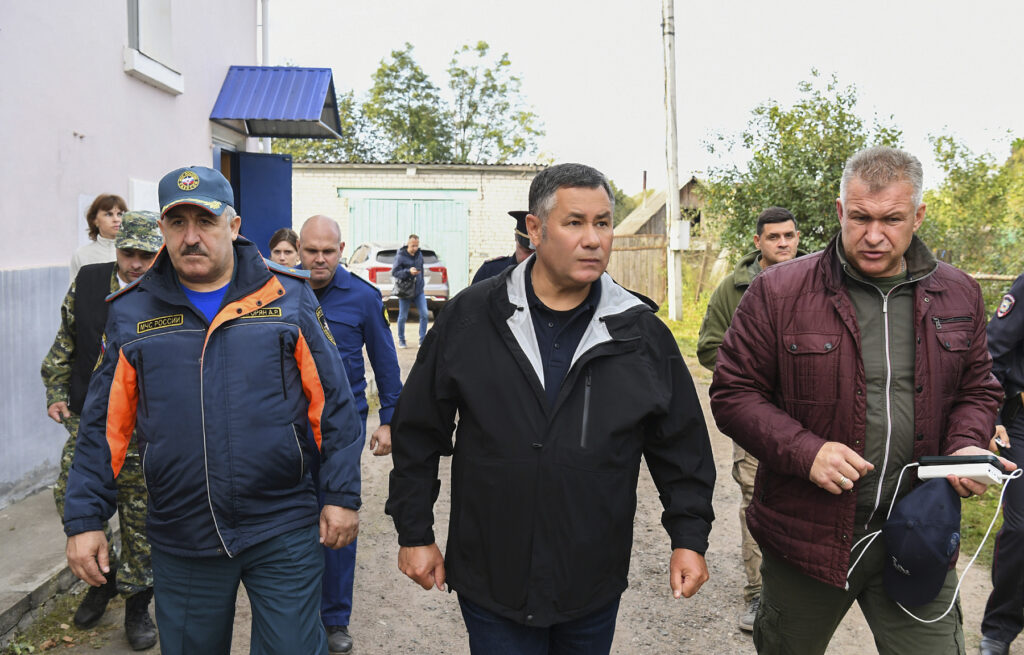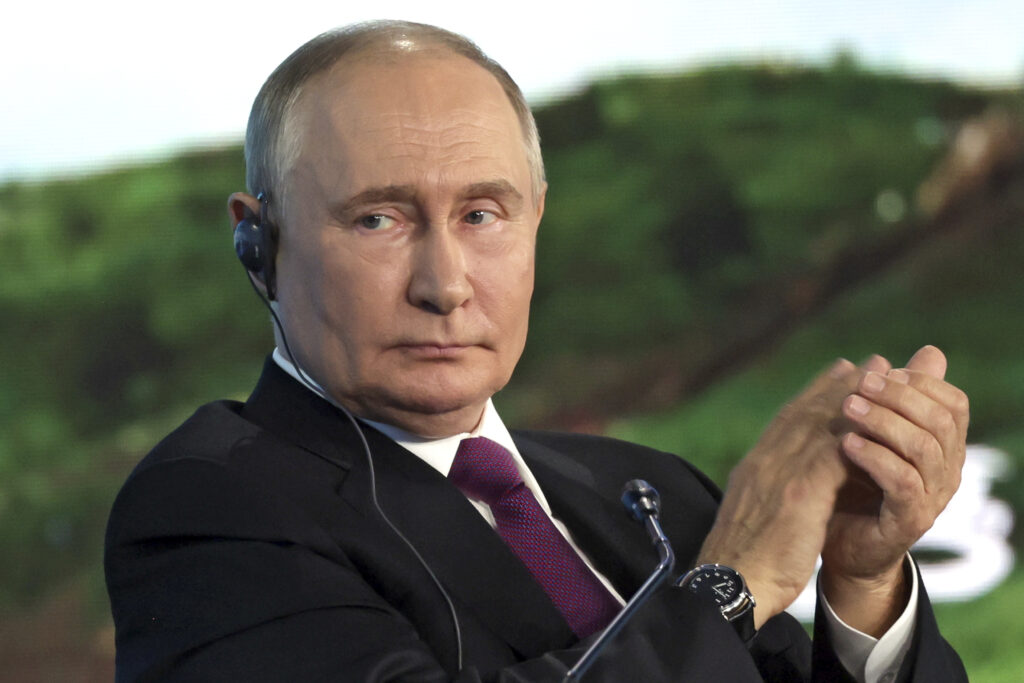Ukraine, Without American Missiles, Sends Up Non-Nuclear Mushroom Cloud Over Russia
Attack on ammunition dump shakes the steppes with the force of an earthquake.

Ukraine has beaten Russia in a race to shake the steppes with an earthquake and send up a mushroom cloud visible from outer space. For weeks, Russian commentators have urged the Kremlin to drop a nuclear weapon on Ukraine. Yesterday, it was Ukraine who pulled off what may be the single largest explosion of the war. They did it the old fashioned, non-nuclear way: blowing up an ammunition dump.
The central explosion was so massive that seismic stations as far away as Estonia registered a 2.8 magnitude earthquake. In outer space, NASA satellites orbiting above the earth detected intense heat signatures from the five square mile area, near Toropets, in western Russia’s Tver region.
On the ground at Toropets, the initial mushroom cloud and subsequent fires blew out windows, flattened two villages, injured dozens of people, and forced the temporary evacuation of 3,000 more. Some villagers, caught between explosions and a lake, cowered on a shoreline, watching as fires burned for 12 hours.
“The situation is under control,” the governor of the Tver Region, Igor Rudenya, grimly lectured in a video recorded 10 hours after the first blast. While he talked, TV viewers could hear artillery shells cooking off in the background. The governor said a fire had been caused by debris from downed drones. However, Russia’s Defense Ministry did not report shooting down any drones yesterday over the Tver region.

In reality, a swarm of over 100 kamikaze drones had flown north from Ukraine. In the light of the full moon, they must have looked like a cauldron of bats. After three hours and 300 miles, they started dive bombing their target: one of Russia’s largest military stockpiles forward deployed in Western Russia.
Completed in 2018, the arsenal was touted as built to the world’s highest standards of safety and fire control. The project organizer, Deputy Defense Minister Dmitry Bulgakov, boasted to TV reporters that the new, $100 million depot was “protected from air and missile strikes, and even from the damaging effects of a nuclear explosion.” Six weeks ago, General Bulgakov was arrested on charges of fraud, stemming from an unrelated case — allegedly taking bribes to provide substandard rations to soldiers.
In reality, many munitions at Toropets were stored in the open air, protected by earthen berms. According to Ukrainian military intelligence, the depot contained a total of between 20,000 tons and 30,000 tons of weapons: 82mm mortar shells, 122mm Grad rockets, S-300 and S-400 air defense missiles, Iskander and Tochka-U cruise missiles, and North Korean-made KN-23 ballistic missiles.
“Without exaggeration, this is a very significant achievement,” Ukrainian intelligence group Frontelligence Insight posted. “We’re likely looking at the loss of thousands of tons of explosive materials, shells and rockets.”

A former Ukrainian internal affairs advisor, Anton Gerashchenko, posted on X that Russian reports say the main explosion was the equivalent of between 1.3 kilotons and 1.8 kilotons of TNT. For comparison, the American nuclear bomb dropped on Hiroshima was 15 kilotons.
“The main explosion looks like a nuclear bomb went off,” posted pro-Ukrainian Twitter blogger Kremlin Trolls. “Extraordinary achievement, and possibly one of the biggest set of detonations of the war so far.”
Russian opposition group Rospartizan focused on the unequal distribution of air defenses around Russia. It posted on Telegram: “This is already the third raid on those warehouses. But the air defense is focused on defending Putin’s residence in Valdai — that’s where the khan raises his offspring.”
Flush with cash, but facing a looming weapons and munitions shortage, Russia’s former defense minister, Sergei Shoigu, reportedly visited three allies over the last week — North Korea, Iran and Syria.
For months, Russian state TV commentators have urged the Kremlin to go nuclear — to drop nuclear bombs either on Ukraine, or on a European capital. As measured by numbers of nuclear warheads, Russia is the world’s largest nuclear power.

Until recently, President Putin used this nuclear talk to intimidate Europe and America. Last week, his public position hardened as the Biden Administration mulled allowing Ukraine to use American and British missiles to hit Russian military targets within 200 miles of the Ukrainian border. Mr. Putin said on Thursday an American decision to unleash the missiles would change “the very essence” of the war and would mean that NATO is at war with Russia.
Over the weekend, a reporter for the Russian government’s official newspaper, Rossiyskaya Gazeta, flew 1,000 miles north from Moscow to Novaya Zemlya, a military-run island normally closed to outsiders. There he interviewed Rear Admiral Andrei Sinitsyn, head of Russia’s nuclear weapons testing site. From 1954 to 1990, the Soviet Union conducted 224 nuclear tests on the island, some open air, some underground.
“The test site is ready for resumption of full-scale testing activities,” Admiral Sinitsyn told Russia’s official newspaper. “It is ready in its entirety. Laboratory and testing facilities are ready. The personnel are ready. If the order comes, we can start testing at any moment.”
With yesterday’s raid on the Toropolets arsenal, the Biden administration may argue that Ukraine no longer needs American “long range” tactical missiles, which can only fly 190 miles. Indeed, Ukrainian drones yesterday also hit Engels-2, a Russian bomber base near Saratov. That base is 300 miles east of Ukraine.
In addition to long range drones, Ukraine is building long-range missiles designed to hit targets 1,000 miles away or more. During the Cold War, Ukrainian engineers and machinists based in the closed city of Dnipropetrovsk designed and built the intercontinental ballistic missiles, or ICBMs, that were aimed at New York and Washington.
Late next week, Presidents Biden and Zelensky are to meet at New York. One topic is to be the Ukrainian president’s “Victory Plan.” He travels to New York with one victory notched on his belt.
“A very important result was achieved last night on Russian territory and such actions weaken the enemy,” Mr. Zelensky said last night about the drone raid on Toropets. “I thank everyone involved. Such precision is truly inspiring.”

